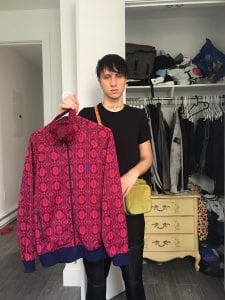Elijah told me he dresses with personas, building outfits from the identities that some garments may convey. As a fashion designer, he is very in-tune with what a garment may signify; he considers the “semiotics” of clothing. For example, he often wears “wife beaters” (white ribbed tank-tops), very much aware of their trashy, undergarment connotations and their cheap appearance. Another theme that emerged is Elijah’s play with formality in his daily life. As an art student there are nearly no occasions for him to need a suit or formal shirt, so when details like lapels enter his wardrobe, they are added playfully and with random other garments. Finally, Elijah’s disdain for his work uniform is obvious; he leaves his apron and button down dirty and crumpled in the bottom of his bag.
Elijah begins by opening one of two T-shirt drawers somewhat arbitrarily. After that, he selects either pants or outerwear — since they are hung on the same rack and he usually chooses within five seconds of looking. Sometimes his outfits are based around a particularly loud or dissonant piece, like a rhinestone belt, a bright green bag, or a very decorated/patterned garment. I also noticed that he owns probably 2 pairs of jeans, and 10 pairs of black pants, yet each pair of black pants has a unique silhouette and fabric. Elijah can select a pair of black pants near-immediately, simply remembering them by the slight difference in fabric and hand. I share closet space with Elijah but I don’t actually understand how he selects clothes because everything looks the same folded, but he knows exactly what garments he wants by looking once. “As a [woman] stands looking at her wardrobe, the relationship is primarily visual, entailed by the physical distance, as the rail positions all clothing as potential items from which she might select.” (Woodward 2007, 40)
Elijah’s dress practice shares some similarities and differences to mine. We both start by seeing what garments are clean and building up from there. I, however, have a more eclectic style (or no style preference at all), so I first have to decide who I want to be that day, while Elijah does have a style and plays within that day by day. My gender, my race position (POC), my age and the neighborhood I grew up in differ from Elijah’s so our influences come from different places, and that shows in the way we dress and how we decide.
Woodward, Sophie. Why Women Wear What They Wear (London: Berg Publishers 2007), 40.

